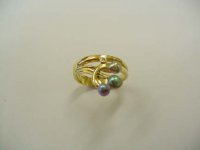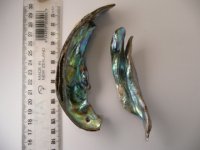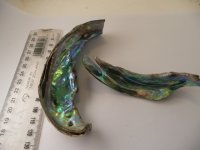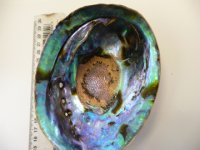You are using an out of date browser. It may not display this or other websites correctly.
You should upgrade or use an alternative browser.
You should upgrade or use an alternative browser.
Natural Paua Pearls
- Thread starter hopepaua
- Start date
G
GemGeek
Guest
Such a treasure! 
J Marcus
New Member
The Pearl Head Nymph Has Arrived!
The Pearl Head Nymph Has Arrived!
It's here! It's here! The lovely fly pictured earlier in this thread has arrived and it's truly a beauty! Rob and Denise outdid themselves and my fly showed up yesterday in it's own royal red pouch with a certificate and other materials. As soon as I am able I'll post a picture or two. It's such fun! Well, Well--now, how to reciprocate. . . Certainly they have my fondest gratitude!
J Marcus
http://www.flyrodjewelry.com/home.html
Life's a beach and then you flounder--Hopefully you land among the pearls. . .
The Pearl Head Nymph Has Arrived!
It's here! It's here! The lovely fly pictured earlier in this thread has arrived and it's truly a beauty! Rob and Denise outdid themselves and my fly showed up yesterday in it's own royal red pouch with a certificate and other materials. As soon as I am able I'll post a picture or two. It's such fun! Well, Well--now, how to reciprocate. . . Certainly they have my fondest gratitude!
J Marcus
http://www.flyrodjewelry.com/home.html
Life's a beach and then you flounder--Hopefully you land among the pearls. . .
Last edited:
J
jerin
Guest
Congratulations!
Nerida
Member
NZ pearls - thanks for the gorgeous photo of the unfinished strand. Any idea of retail value? The colours are scrumptious!
SteveM
Well-known member
- Joined
- Jan 29, 2007
- Messages
- 2,117
Would take this one step at a time. NZ Pearls, may we know the total carat weight of the pearls selected to date?NZ pearls - thanks for the gorgeous photo of the unfinished strand. Any idea of retail value? The colours are scrumptious!
New Zealand Natural Pearl
New Member
J
jerin
Guest
Lovely ring!
Nerida
Member
Would take this one step at a time.
Hey Steve, I'm a woman -when it comes to beautiful things, I just want to know if it's within my reach or not! Of course though, you are right - NZ pearls - what length has been gathered so far, and what sizes are those gorgeous pearls? It is such a pretty piece, even without being completed.
Sueki
Pearl Collector & Designer
Sigh,
These pearls are so beautiful...
These pearls are so beautiful...
richipat
New Member
I agree with Sueki ---  ~ sigh~
~ sigh~
SteveM
Well-known member
- Joined
- Jan 29, 2007
- Messages
- 2,117
Paua: This is the Maori name for Haliotis Iris, the intensely colored variety of abalone native to the cold waters of NZ and Chatham Islands.
Value: Much can happen between now and the eventual sale of this totally unique necklace. So we are forced to speculate?a position strongly in favor of the seller!
Value: Much can happen between now and the eventual sale of this totally unique necklace. So we are forced to speculate?a position strongly in favor of the seller!
Caitlin
Well-known member
Thanks for the delicious photos Denise! Keep them coming! Like others. I want to know more details about both the ring and necklace
New Zealand Natural Pearl
New Member
A small Selection of Naturals
A small Selection of Naturals
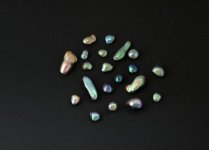
Sorry about delay with replying.
The necklace weighs 28ct so far. We are
adding pearls as we find them. Will post
completed ONE day.
The ring is 18ct yellow gold with diamond
1.6ct natural abalone gem grade pearl. Value $1600.00U.S.
The attached selection of natural abalone freeforms weighs
16.53ct - Beautiful colours. Posting a new bug on
"Gone Buggy" today or tomorrow - watch out
A small Selection of Naturals

Sorry about delay with replying.
The necklace weighs 28ct so far. We are
adding pearls as we find them. Will post
completed ONE day.
The ring is 18ct yellow gold with diamond
1.6ct natural abalone gem grade pearl. Value $1600.00U.S.
The attached selection of natural abalone freeforms weighs
16.53ct - Beautiful colours. Posting a new bug on
"Gone Buggy" today or tomorrow - watch out
J Marcus
New Member
My--the selection of naturals above is absolutely georgeous! Could you give us an idea of the range of sizes (mm) in that little group?
Marc
http://www.flyrodjewelry.com/home.html
Marc
http://www.flyrodjewelry.com/home.html
New Zealand Natural Pearl
New Member
Size
Size
The gold pearl on the far left is 2.21ct and 1.3 c.m.
Size
The gold pearl on the far left is 2.21ct and 1.3 c.m.
New Zealand Natural Pearl
New Member
Wing of a Pearl
Wing of a Pearl
[/ATTACH][/ATTACH][/AT
TACH]
Here are some interesting pieces we call WING Shape.
These are formed in very interesting way.
Does anyone have any idea? - There may be a prize.
Are these wing shapes common in the Califorian or Mexican
Abalone.?
Wing of a Pearl
[/ATTACH][/ATTACH][/AT
TACH]
Here are some interesting pieces we call WING Shape.
These are formed in very interesting way.
Does anyone have any idea? - There may be a prize.
Are these wing shapes common in the Califorian or Mexican
Abalone.?
Attachments
J Marcus
New Member
I would have to say that the type of pearl formation you show there is definitely not common in the Pacific--at least in my experience. I do have a very few shells that show at least the beginnings of formations like what is in the whole shell that you have posted, but I don't think that any of them are quite grown to that extent--with the possible exception of one that showed up in a Pinto abalone (H. Kamchatkensis [not sure of spelling. . . ]) of all things. They have quite thin shells. I only know the present whereabouts of a couple of them but as soon as I can find and photo them I'll post pictures. (It may take a while.) As for their cause I'm unsure, though it does seem that they are associated with parasites or some other pathology. I have at least one shell where it looks like the abalone has tried to create a separate layer to the shell inside of the original. Very interesting. It looks like the separate ones that you show may have been cut off of the shell. Am I right? My--you certainly have some interesting anomolies. Have you found anything like my "berry blisters?"
Marc
http://www.flyrodjewelry.com/home.html
Marc
http://www.flyrodjewelry.com/home.html
blue pearl
New Member
Wing blisters
Wing blisters
In my experience this type of pearl formation is quite common in the Pacific.
It is probably caused buy physical damage or something foreign.
Paua have pearls (natural) or blisters that are caused mostly by physical damage or a reaction to something they don't like against the inner body of the paua.Animals that bore in from the outside of the shell to create natural pearls or blisters is not something I have seen in paua.
Wing blisters
In my experience this type of pearl formation is quite common in the Pacific.
It is probably caused buy physical damage or something foreign.
Paua have pearls (natural) or blisters that are caused mostly by physical damage or a reaction to something they don't like against the inner body of the paua.Animals that bore in from the outside of the shell to create natural pearls or blisters is not something I have seen in paua.
Similar threads
- Replies
- 14
- Views
- 3K
- Replies
- 9
- Views
- 849

